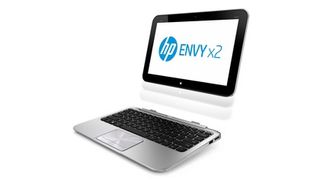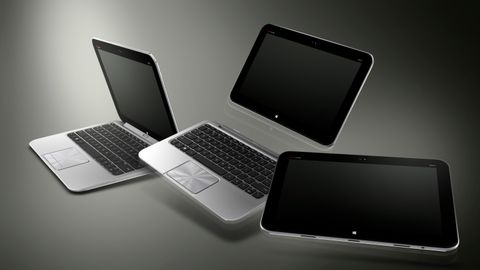TechRadar Verdict
In the end, though, we see so much potential in the Envy x2 we're willing to overlook some of its awkwardness. It's the type of device that is sure to improve over time, and it's showing the way to the undeniable future of ultralight laptops.
Pros
- +
Excellent hybrid design
- +
Exceptionally long battery life
- +
Light and runs very cool
- +
Runs all Windows applications
Cons
- -
Tablet a bit oversizeD
- -
Paltry mass storage
- -
Limited tablet-optimized apps
- -
Poor 3D graphics performance
Why you can trust TechRadar
The line between tablets and laptops is getting very blurry very fast. After all, except for high-end portable workstations and gaming rigs, a typical laptop PC is little more than a tablet with a keyboard. HP merges the two types beautifully with its Envy x2, creating a hybrid Windows 8 tablet/laptop that works equally well in both guises.
There are two ways to conceptualize the Envy x2. One way is to think of it as a notebook where the screen comes off and can be used as a tablet. It's better, though, to think of it as a tablet with an optional keyboard that also functions as a docking station. This docking station offers sundry connectors and a second battery.
If you're used to the traditional paradigm of a laptop PC, the keyboard base takes some getting used to. Of course, in a normal laptop, the guts are all located in the base of the computer and the screen is just that - nothing more than a display. The Envy x2 turns this paradigm on its head. The screen includes the guts of the computer, including the CPU, memory, and storage. The keyboard includes nothing essential to running the computer, though it does include a second battery.

So, it's best to think of the keyboard base as more like a docking station than anything else. There are no moving parts of any kind inside the keyboard - no DVD drive and no mechanical hard drive. Its main function, beyond providing a keyboard and touchpad, is to offer connectors for peripherals and for the power supply. The second battery provides the only real internal functionality.
Looking for a bargain with your plans? One of the many HP promo codes could be just what you need.
Keyboard
We were very impressed with how easy it is to connect and disconnect the tablet from the keyboard. The keyboard base has three connectors on it: two magnetic posts which guide the tablet down onto the main proprietary connector which delivers the power and data. It's easy to securely make this connection just by feel, and once connected, it's a very solid fit.
There's only a few seconds delay between connecting the keyboard and being able to use it. The transition is seamless since all the processing and memory are housed in the tablet. It's much like connecting a USB mouse to a laptop. Disconnecting it is just as easy. You simply move the slider at the top of the keyboard to release the latch and the tablet comes free.
The docking base features a full-sized "island style" (read: chiclet) keyboard which we found responsive and pleasant to use. The trackpad is wide and responsive and includes a button which lets you turn it off or on.
On the left side of the keyboard you'll find a full-sized HDMI connector for connecting to an external monitor, projector or TV, one USB 2.0 port, and a combo headphone/microphone jack. You can plug a regular pair of headphones into this jack or you can use a headset which supports this type of mini-jack to connect both a microphone and headphone. However, if you just want to plug a regular microphone into this jack, or if want to use a separate headphone and microphone, you'll need to use a splitter.
On the right of the keyboard base, there is a second USB 2.0 port and the power connector. HP uses a proprietary flat power connector which has a small light which lets you know when the system is finished charging. You'll also find a slot for an SD card, so you can upload photos from your camera. HP's covered the basics with these connectors, but all things being equal, we would have preferred one or two more USB ports and separate connectors for a microphone and headphones.
An Ethernet connector is the main thing lacking from the keyboard base. This isn't surprising, since the base isn't really thick enough for the industrial designers to squeeze in an RJ-45 jack. However, since the system runs Windows 8, it would be no problem to purchase an inexpensive USB Ethernet adaptor. That, of course, is the advantage of a Windows-based hybrid computer like this: standard PC peripherals and adapters work seamlessly. However, the tablet has no USB ports; if you want to use USB peripherals, you the tablet needs to be docked into the keyboard base.
Tablet functions
Using the Envy x2 as a tablet, the first thing you'll notice is its size. It's really big. It might even be a little too big. Not only is it about half an inch wider than an iPad, it's over two inches longer. The display is 11.6 inches measured diagonally, compared to only 9.7 inches for the iPad. That's a big difference, and for some uses, it's a definite bonus. For others, we think it might get annoying. For instance, in reading a book, we found it a bit unwieldy when trying to hold it with one hand.
The screen resolution is 1366 x 768 with a 16:9 aspect ratio. That's pretty much ideal for watching videos, and the pixel density is comparable to the iPad 2. In this age of Retina displays, though, you might find it a bit grainy for reading books or doing other close-up work. That's not likely to be a problem when using it in laptop mode. Overall the LED-backlit IPS Display screen is bright and clear, and looks excellent from a wide viewing angle. However, like most tablets, we found it very reflective in the sunlight; it isn't ideal for beach time work.

Besides the gargantuan proportions, it's a pretty standard tablet design. There is a large Windows Start button at the bottom that lights up and vibrates the whole device when pressed. This button seems to be disabled when docked to the keyboard.
On the back there is an on/off button and volume buttons which are completely flush against the brushed aluminum exterior. They are a bit hard to find at first, and since the buttons feel pretty similar except for their size, we think it would be pretty easy to accidentally turn it off when you are trying to change the volume and vice versa.
The power supply connects to the Envy x2 through a proprietary connector that looks similar to the original flat iPod connector. It's possible to plug the power cable directly into tablet or to recharge it via the keyboard. There's no technical reason why HP couldn't produce an accessory allowing you to output an HDMI signal directly from the tablet, without needing the keyboard base, but the company hasn't yet released such an accessory.

